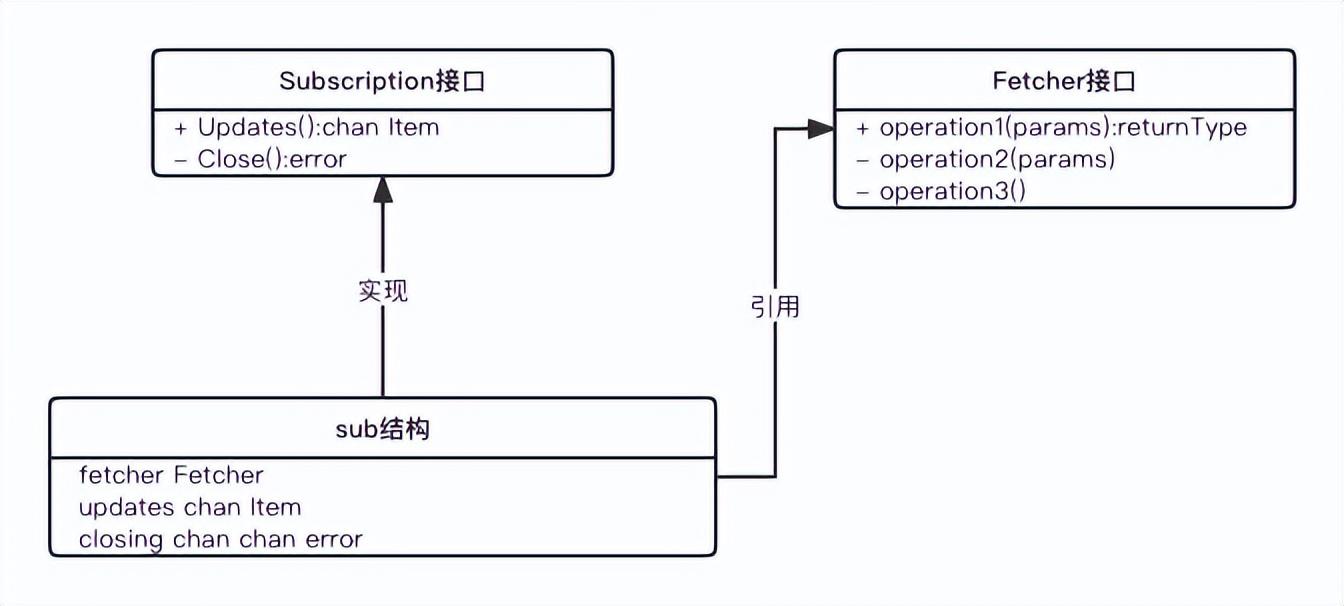
背景
在并发处理中,资源争用是一个常见的问题。为了避免资源争用,需要进行优化。以下是一些可以优化并发处理中的资源争用问题的建议:
- 避免锁竞争:锁竞争是一种常见的资源争用问题。可以通过减少锁的使用,使用更细粒度的锁,以及避免不必要的锁竞争来减少锁竞争。
- 使用缓存:在一些情况下,可以使用缓存来减少资源争用。例如,在处理一些计算密集型的任务时,可以使用缓存来避免重复计算。
- 使用原子操作:原子操作可以在不使用锁的情况下实现资源的同步访问。Go 语言中提供了一些原子操作,例如 atomic.AddInt32 和 atomic.LoadInt32 等,可以用于实现线程安全的资源访问。
- 使用互斥锁:互斥锁是一种用于避免并发资源争用的机制。在需要对资源进行访问的时候,可以使用互斥锁来保证资源的独占访问。
- 使用读写锁:读写锁是一种特殊的互斥锁,可以允许多个读操作同时进行,但是只允许一个写操作进行。在读操作频繁的场景下,可以使用读写锁来提高并发性能。
- 使用条件变量:条件变量是一种用于在不同线程之间进行协调的机制。可以使用条件变量来避免不必要的资源争用。例如,在一个生产者-消费者模式的程序中,可以使用条件变量来协调生产者和消费者之间的交互,从而避免资源争用。
但是如果让你不用锁,条件变量,回调的话,还怎么写并发程序啊,谷歌大佬Sameer给了大家一个思路。"Advanced Go Concurrency Patterns" by Sameer Ajmani: 这篇博客深入研究了 Golang 中的并发模式,并讨论了如何使用它们来构建高性能系统。它仅仅使用了Go语言的goroutine和channel便实现高效异步并发编程,没有用到诸如await,context等包括锁,条件变量,和回调函数,文章包括一些示例和实践建议,帮助读者更好地理解和实践这些概念。下面我们针对他给出的case做一些说明与总结,同时对go语言并发编程的语言特性与技巧进行总结,换句话就是说想提炼出面向场景的go语言高并发编程的八股模式。
select-loop的编程关键要素
1.如何处理事件
2.如何处理元素
3.如何关闭退出
代码示例:

核心结构与接口
下面代码给出了核心结构sub,以及它实现了接口subscription的关键代码。
- updates属性是一个通道,用于用户对元素进行处理。
- fetcher是用于获取元素的客户端,它可以是从数据库读取,也可以是从消息队列读取。
- closing用于关闭退出select-loop主体
// sub implements the Subscription interface.
type sub struct {
fetcher Fetcher // fetches items
updates chan Item // sends items to the user
closing chan chan error // for Close
}
func (s *sub) Updates() <-chan Item {
return s.updates
}
func (s *sub) Close() error {
errc := make(chan error)
s.closing <- errc // 向closing通道中同步写入errc
return <-errc // 等待主loop返回
}
// Subscribe returns a new Subscription that uses fetcher to fetch Items.
func Subscribe(fetcher Fetcher) Subscription {
s := &sub{
fetcher: fetcher,
updates: make(chan Item), // for Updates
closing: make(chan chan error), // for Close
}
go s.loop()
return s
}sub的核心处理逻辑
// loop periodically fecthes Items, sends them on s.updates, and exits
// when Close is called. It extends dedupeLoop with logic to run
// Fetch asynchronously.
func (s *sub) loop() {
const maxPending = 10
type fetchResult struct {
fetched []Item
next time.Time
err error
}
var fetchDone chan fetchResult // if non-nil, Fetch is running
var pending []Item
var next time.Time
var err error
var seen = make(map[string]bool)
for {
var fetchDelay time.Duration
if now := time.Now(); next.After(now) {
fetchDelay = next.Sub(now)
}
var startFetch <-chan time.Time
if fetchDone == nil && len(pending) < maxPending {
//等待队列长度未超过最大设置且fetchDone是空,即元素已经都入队列了
// 设置fetchDelay时间后,startFetch通道有值
startFetch = time.After(fetchDelay)
}
var first Item
var updates chan Item
if len(pending) > 0 {
first = pending[0]
updates = s.updates // updates通道是为了用户进一步消费的
}
select {
case <-startFetch:
fetchDone = make(chan fetchResult, 1)
go func() {
fetched, next, err := s.fetcher.Fetch()
fetchDone <- fetchResult{fetched, next, err}
}()
case result := <-fetchDone:
fetchDone = nil
// Use result.fetched, result.next, result.err
fetched := result.fetched
next, err = result.next, result.err
if err != nil {
next = time.Now().Add(10 * time.Second)
break
}
for _, item := range fetched {
if id := item.GUID; !seen[id] {
pending = append(pending, item)
seen[id] = true
}
}
case errc := <-s.closing:
errc <- err
close(s.updates)
return
case updates <- first:
pending = pending[1:]
}
}
}那么上面的代码是如何处理三个关键问题的呢?
- 首先关于关闭并退出loop
上述代码通过监听sub结构的closing属性,实现退出。
//Close asks loop to exit and waits for a response.
func (s *sub) Close() error {
errc := make(chan error)
s.closing <- errc
return <-errc
}当调用sub的Close方法时,s.closing会接收一个errc的通道,loop主体向errc中写入error信息并退出,调用sub的Close方法的客户端从errc中也同步收到error信息。这是一个同步关闭的过程。loop主体可以在给客户端发送error信息之前,可以完成一系列的关闭清理工作。
- 关于事件处理与调度
程序中设置的下一次获取元素的延迟调度的最小单位是10秒,从下面第22行可以看到,如果获取元素很快,没有耗费10秒,那么fetchDelay便有个时间gap,startFetch(第7行)这个时间通道便会通过time.After这个方法,在fetchDelay时间后,收到信号,完成18到25行的获取元素工作。
var pending []Item // appended by fetch; consumed by send
var next time.Time // initially January 1, year 0
var err error
for {
var fetchDelay time.Duration // initially 0 (no delay)
if now := time.Now(); next.After(now) {
fetchDelay = next.Sub(now)
}
startFetch := time.After(fetchDelay)
select {
case <-startFetch:
var fetched []Item
fetched, next, err = s.fetcher.Fetch()
if err != nil {
next = time.Now().Add(10 * time.Second)
break
}
pending = append(pending, fetched...)
}
}问题:为了防止等待队列过大,所以只有当长度不超过maxPending,并且获取的数据已经入队了的时候,才会设置startFetch,否则就不触发fetch。这块可以结合上面整个代码看看
var fetchDelay time.Duration
if now := time.Now(); next.After(now) {
fetchDelay = next.Sub(now)
}
var startFetch <-chan time.Time
if fetchDone == nil && len(pending) < maxPending {
startFetch = time.After(fetchDelay) // enable fetch case
}问题: Loop blocks on Fetch。
golang有个特性,就是Sends and receives on nil channels block.利用这个特性,当fetchDone是nil或者他里面没有准备好结果的时候,相关的case都会阻塞,那么select也不会选择它。同时为了防止fetch函数阻塞loop主函数,通过启动协程(下面9-12行),再次提升主loop的性能。
type fetchResult struct{ fetched []Item; next time.Time; err error }var fetchDone chan fetchResult // if non-nil, Fetch is running
var startFetch <-chan time.Time
if fetchDone == nil && len(pending) < maxPending {
startFetch = time.After(fetchDelay) // enable fetch case
}
select {
case <-startFetch:
fetchDone = make(chan fetchResult, 1)
go func() {
fetched, next, err := s.fetcher.Fetch()
fetchDone <- fetchResult{fetched, next, err}
}()
case result := <-fetchDone:
fetchDone = nil
// Use result.fetched, result.next, result.err总结
上面用到了3个技巧,如下所示:
- for-select loop
- service channel, reply channels (chan chan error)
- nil channels in select cases
通过err,next,pending三个变量,就实现了在没有锁,条件变量,回调情况下,编写高效并发go程序的需求。


































